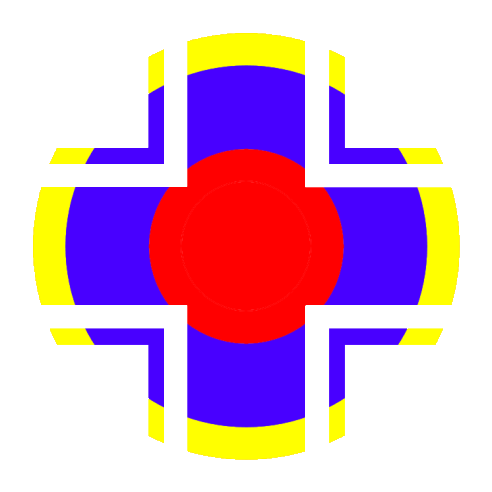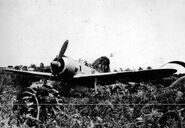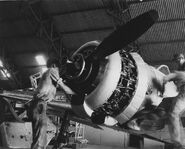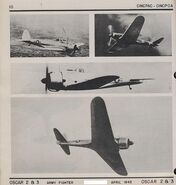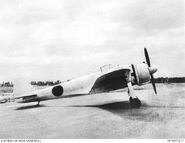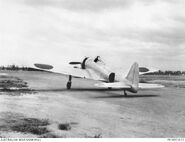(Adding categories) |
mNo edit summary Tag: Visual edit |
||
| (One intermediate revision by the same user not shown) | |||
| Line 3: | Line 3: | ||
|image=[[file:XJ002-AWM-4096130.JPG|thumb|300px]] |
|image=[[file:XJ002-AWM-4096130.JPG|thumb|300px]] |
||
|caption=Running up the engine for its first test flight. Photo from Australian War Memorial<ref>https://www.awm.gov.au/collection/C196545</ref> |
|caption=Running up the engine for its first test flight. Photo from Australian War Memorial<ref>https://www.awm.gov.au/collection/C196545</ref> |
||
| − | |designation=[[:Category:Nakajima Ki-43|Nakajima Ki-43 'Oscar']] |
+ | |designation=[[:Category:Nakajima Ki-43|Nakajima Ki-43 'Hayabusa' (Allied code name 'Oscar')]] |
| − | |version=Ki-43-I Kō |
+ | |version= Ki-43-I Kō (Ki-43-Ia) |
}} |
}} |
||
| Line 10: | Line 10: | ||
=== Japanese service === |
=== Japanese service === |
||
Built by Nakajima between April to December 1942. The manufacture number of this aircraft is unknown, it can be either Ki-43 C/n 400, Ki-43 C/n 426, Ki-43 C/n 622, Ki-43 C/n 779 or Ki-43 C/n 805. Delivered to the Japanese Army Air Force (JAAF) as Type 1 Hayabusa Ki-43-I Ko (Allied code name "Oscar"). Assigned to the 11th Sentai. During 1943, this aircraft operated from Lae Airfield. It was abandoned largely intact, but with the tail rudder and fabric surfaces damaged and the cockpit canopy glass missing.<ref>http://www.ozatwar.com/ozatwar/oscar.htm</ref> This aircraft was in Japanese service painted with green upper surfaces with the fuselage Hinomaru outlined in white. The rear had a white vertical stripe rear aft of the Hinomaru. The leading edge of the wing had a yellow recognition stripe. The tail had the the lightning bolt motif of the 11th Sentai.<ref name="www.pacificwrecks.com-ki-43">https://www.pacificwrecks.com/aircraft/ki-43/lae.html</ref> |
Built by Nakajima between April to December 1942. The manufacture number of this aircraft is unknown, it can be either Ki-43 C/n 400, Ki-43 C/n 426, Ki-43 C/n 622, Ki-43 C/n 779 or Ki-43 C/n 805. Delivered to the Japanese Army Air Force (JAAF) as Type 1 Hayabusa Ki-43-I Ko (Allied code name "Oscar"). Assigned to the 11th Sentai. During 1943, this aircraft operated from Lae Airfield. It was abandoned largely intact, but with the tail rudder and fabric surfaces damaged and the cockpit canopy glass missing.<ref>http://www.ozatwar.com/ozatwar/oscar.htm</ref> This aircraft was in Japanese service painted with green upper surfaces with the fuselage Hinomaru outlined in white. The rear had a white vertical stripe rear aft of the Hinomaru. The leading edge of the wing had a yellow recognition stripe. The tail had the the lightning bolt motif of the 11th Sentai.<ref name="www.pacificwrecks.com-ki-43">https://www.pacificwrecks.com/aircraft/ki-43/lae.html</ref> |
||
| + | <gallery> |
||
| − | <gallery>file:os02.jpg|The aircraft when found |
||
| − | file: |
+ | file:os02.jpg|The aircraft when found |
| + | file:os03.jpg|Another angle |
||
| + | 580918_206899209444060_1442621929_n.jpg|Men from ATAIU working on a Japanese Oscar (XJ002) inside Hangar 7 at Eagle Farm Airfield in Brisbane, Australia in 1944 via http://www.hangar7.org.au/ |
||
| + | </gallery> |
||
=== In Allied hands === |
=== In Allied hands === |
||
Latest revision as of 23:26, 29 January 2018
History[]
Japanese service[]
Built by Nakajima between April to December 1942. The manufacture number of this aircraft is unknown, it can be either Ki-43 C/n 400, Ki-43 C/n 426, Ki-43 C/n 622, Ki-43 C/n 779 or Ki-43 C/n 805. Delivered to the Japanese Army Air Force (JAAF) as Type 1 Hayabusa Ki-43-I Ko (Allied code name "Oscar"). Assigned to the 11th Sentai. During 1943, this aircraft operated from Lae Airfield. It was abandoned largely intact, but with the tail rudder and fabric surfaces damaged and the cockpit canopy glass missing.[2] This aircraft was in Japanese service painted with green upper surfaces with the fuselage Hinomaru outlined in white. The rear had a white vertical stripe rear aft of the Hinomaru. The leading edge of the wing had a yellow recognition stripe. The tail had the the lightning bolt motif of the 11th Sentai.[3]
In Allied hands[]
During late September 1943 Lae was captured by the Australian Army and the area was occupied by the Allies whereupon the aircraft was found. Afterwards, this aircraft was disassembled and shipped to Brisbane and transported to Hangar 7 at Eagle Farm Airfield, where the aircraft was reassembled and restored to flying condition by the then Air Technical Intelligence Unit (ATIU) that operated out of Hanger 7 at Eagle Farm Airfield, using parts of the various airframes named earlier. When ready, it was flown and tested as XJ002 at Eagle Farm Airbase, Brisbane, Queensland, Australia.[3]
Markings[]
While being restored, most of the green paint was stripped off to bare metal. After restoration, the aircraft was painted green with U. S. markings and tail code XJ002 in black on both sides of the tail.[3] Later the aircraft was repainted in japanese markings for recognition manual purposes.
Test Flights[]
On March 17, 1944 this aircraft was test flown by USAAF test pilot Captain William O. Farrior for 25 minutes. On March 18, 1944 test flown for 55 minutes. Afterwards, the fate of this Oscar is unknown.[3]
